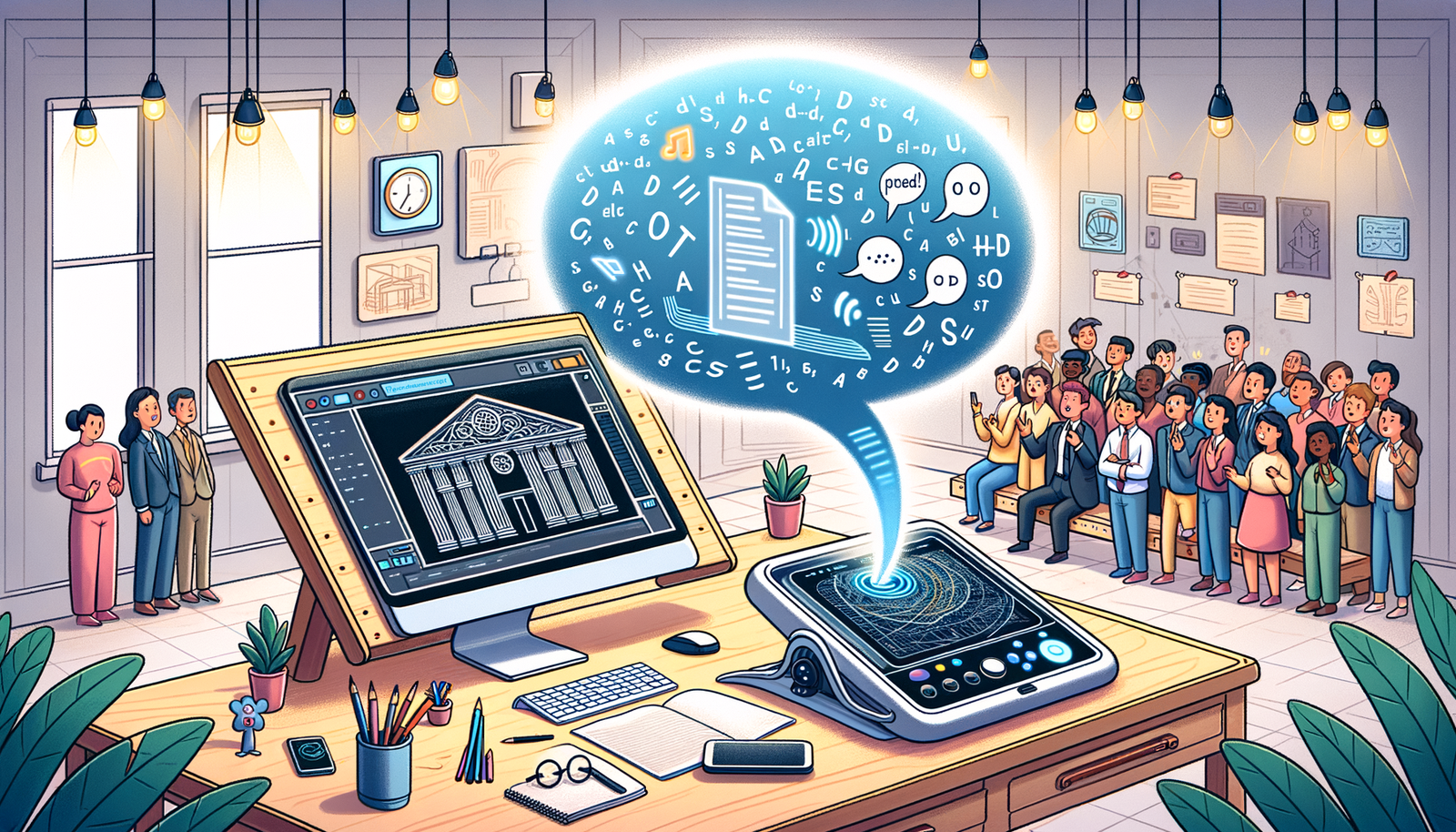Your Cart is Empty
Customer Testimonials
-
"Great customer service. The folks at Novedge were super helpful in navigating a somewhat complicated order including software upgrades and serial numbers in various stages of inactivity. They were friendly and helpful throughout the process.."
Ruben Ruckmark
"Quick & very helpful. We have been using Novedge for years and are very happy with their quick service when we need to make a purchase and excellent support resolving any issues."
Will Woodson
"Scott is the best. He reminds me about subscriptions dates, guides me in the correct direction for updates. He always responds promptly to me. He is literally the reason I continue to work with Novedge and will do so in the future."
Edward Mchugh
"Calvin Lok is “the man”. After my purchase of Sketchup 2021, he called me and provided step-by-step instructions to ease me through difficulties I was having with the setup of my new software."
Mike Borzage
AI-Powered Text-to-Speech: Revolutionizing Accessibility in CAD Software
November 23, 2024 6 min read


Accessibility in design software has become increasingly important in today's inclusive digital landscape. As computer-aided design (CAD) tools are essential for architects, engineers, and designers, ensuring these tools are accessible to all users is paramount. AI-powered text-to-speech technology is emerging as a significant advancement in this realm, offering solutions that enhance usability for individuals with various disabilities. By integrating these technologies, CAD applications can provide a more inclusive experience, allowing users with visual impairments or cognitive challenges to engage effectively with design processes.
In the realm of professional design, the ability to visualize and manipulate complex models is crucial. However, traditional CAD interfaces often present barriers for users with disabilities. For instance, individuals with visual impairments may struggle with the visual-centric nature of CAD tools, while those with cognitive disabilities might find the interfaces overwhelming. Recognizing these challenges, the integration of AI-powered text-to-speech capabilities offers a promising solution. This technology converts on-screen text and visual elements into spoken words, enabling users to interact with software through auditory means. As a result, it opens up new possibilities for inclusivity in design workflows, ensuring that talented professionals are not excluded due to accessibility issues.
Furthermore, the advent of advanced AI has revolutionized the quality and effectiveness of text-to-speech systems. Modern solutions provide natural-sounding voices and can interpret complex technical terminology common in CAD applications. This development not only aids those with disabilities but also enhances the overall user experience for all, including those who prefer auditory learning or multitasking. By adopting AI-powered text-to-speech, CAD software developers can make significant strides towards creating tools that cater to a broader audience, fostering diversity in the design community.
Understanding Accessibility Challenges in Design Software
Design software, particularly CAD applications, is inherently visual and often complex, posing significant accessibility challenges for a diverse user base. Individuals with visual impairments face the most apparent obstacles, as the reliance on graphical interfaces and visual cues can make navigation and interaction exceedingly difficult. Screen elements such as icons, toolbars, and intricate graphics are designed for visual interpretation, leaving those with partial or complete vision loss at a disadvantage. Moreover, the use of color coding and visual contrasts, while helpful for many users, may not be accessible to individuals with color blindness or low vision.
Beyond visual impairments, users with cognitive disabilities also encounter hurdles when using design software. The complexity of CAD interfaces, which often include numerous tools, options, and settings, can be overwhelming. Challenges such as difficulty with concentration, memory, and information processing can hinder the ability to learn and utilize these sophisticated programs effectively. For instance, individuals with dyslexia may struggle with reading technical terms and instructions, while those with attention deficit disorders might find it hard to focus on intricate design tasks for extended periods.
The importance of making design software inclusive cannot be overstated. As the design industry embraces diversity and seeks to leverage the talents of all individuals, ensuring that tools are accessible to everyone is essential. This inclusivity not only benefits users with disabilities but also enhances the overall usability of the software for all users. By addressing accessibility concerns, developers can create more intuitive interfaces, reduce learning curves, and improve efficiency. In essence, making CAD applications more accessible helps break down barriers, allowing for a more diverse range of perspectives and ideas within the design community.
The Role of AI-Powered Text-to-Speech Technology
AI-powered text-to-speech technology stands at the forefront of solutions aimed at overcoming accessibility challenges in design software. At its core, this technology utilizes natural language processing (NLP) and machine learning algorithms to convert written text into spoken words. Advanced systems are capable of generating speech that closely mimics human intonation and pacing, making the auditory experience more natural and engaging. These technologies can interpret and vocalize complex terminology and instructions, which is particularly beneficial in the context of CAD applications where technical jargon is prevalent.
The incorporation of AI-driven text-to-speech in CAD software offers numerous benefits. One of the primary advantages is the improved navigation and user interface interaction for users with visual impairments. By providing auditory feedback for on-screen content, users can navigate menus, select tools, and understand design elements without relying solely on sight. This capability empowers users to engage with the software more independently and effectively.
Additionally, text-to-speech enhances the learning experiences for new users, regardless of their abilities. CAD programs are often complex, and auditory guidance can help users comprehend functions and workflows more quickly. For individuals who are auditory learners, hearing instructions and explanations can reinforce understanding and retention. Moreover, text-to-speech technology can be customized and adapted to individual user preferences, allowing adjustments in speech rate, volume, and language to suit different needs.
Another significant aspect is the potential for text-to-speech to aid users with cognitive disabilities. By providing auditory support, users can reduce the cognitive load associated with processing vast amounts of visual information. Features such as read-aloud commands, spoken tooltips, and verbal confirmation of actions can simplify interactions, making the software more accessible and less intimidating for users who might otherwise struggle.
Benefits of incorporating text-to-speech in CAD software include:
- Improved navigation and user interface interaction for users with visual impairments.
- Enhanced learning experiences for new and auditory learners.
- Customization and adaptability to individual user preferences.
- Reduction of cognitive load for users with cognitive disabilities.
- Inclusivity leading to a more diverse and innovative design community.
Integration of AI-Powered Text-to-Speech in CAD Software
The successful integration of AI-powered text-to-speech technology into CAD applications requires a thoughtful approach that considers the unique demands of design software. Developers must ensure that the technology seamlessly blends with existing interfaces, providing functionality without disrupting the user experience. This involves not only the technical implementation but also understanding the user workflows and how auditory feedback can enhance them.
One of the key strategies is incorporating text-to-speech features directly into the user interface. For example, users could have the option to enable spoken descriptions of tools and commands as they navigate through toolbars and menus. Interactive voice prompts can guide users through complex processes, such as setting up design parameters or adjusting model properties. Additionally, providing auditory alerts for errors or notifications can help keep users informed of important updates without requiring visual attention.
Another important aspect is allowing for customization to cater to individual needs. Users should have control over the voice settings, including language, accent, speed, and volume. Some users may prefer a slow-paced narration to fully absorb the information, while others might opt for a faster delivery. By offering these customizable options, the software becomes more adaptable and user-friendly.
Developers can also integrate AI algorithms that learn from user interactions. Machine learning models can adapt to user behavior, offering more personalized assistance over time. For instance, the system could recognize frequently used commands and provide predictive suggestions or reminders through voice prompts. This not only enhances accessibility but also improves efficiency and productivity for all users.
Implementing text-to-speech technology also involves ensuring compatibility with assistive devices and software. CAD applications should support integration with screen readers and other accessibility tools commonly used by individuals with disabilities. By adhering to universal design principles and industry accessibility standards, developers can create software that is not only cutting-edge but also inclusive.
Key strategies for integrating text-to-speech in CAD software include:
- Embedding voice prompts and spoken tool descriptions within the user interface.
- Allowing for extensive customization of speech settings to suit user preferences.
- Utilizing AI and machine learning to adapt to user behavior and provide personalized assistance.
- Ensuring compatibility with existing assistive technologies and adhering to accessibility standards.
- Providing training and support resources to help users maximize the benefits of text-to-speech features.
Conclusion
Enhancing accessibility in CAD software through the integration of AI-powered text-to-speech technology represents a significant advancement toward inclusivity in the design industry. By addressing the challenges faced by users with visual and cognitive impairments, developers can create tools that empower a wider range of professionals. The benefits of this technology extend beyond accessibility, contributing to improved learning experiences, increased efficiency, and a more intuitive user interface for all.
The broader implications for the design community are profound. As accessibility becomes a standard consideration in software development, the industry moves closer to a future where diversity is not just accepted but actively facilitated. This shift not only enriches the pool of talent but also fosters innovation by bringing diverse perspectives to the forefront.
It is imperative for software developers to prioritize accessibility in their tools. By embracing technologies like AI-powered text-to-speech, they can lead the way in creating an inclusive design environment. Such efforts not only comply with ethical and legal standards but also contribute to the overall advancement of the industry. The call to action is clear: invest in accessibility to unlock the full potential of the design community and pave the way for groundbreaking innovation.
Also in Design News

Rhino 3D Tip: Enhancing Collaborative Workflow with Rhino 3D's Worksession Feature
November 23, 2024 2 min read
Read More
Design Software History: The Evolution and Impact of Biomechanical Modeling in Design Software History
November 23, 2024 5 min read
Read More
Cinema 4D Tip: Maximizing Cinema 4D Efficiency with User Data Integration
November 23, 2024 2 min read
Read MoreSubscribe
Sign up to get the latest on sales, new releases and more …


